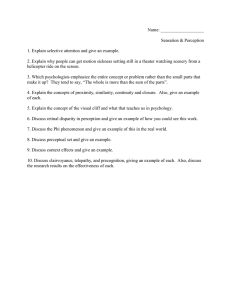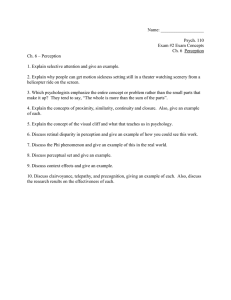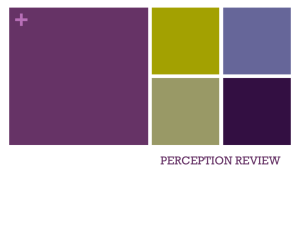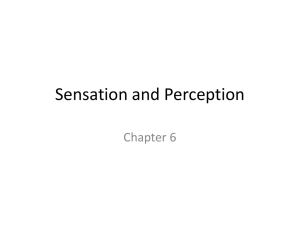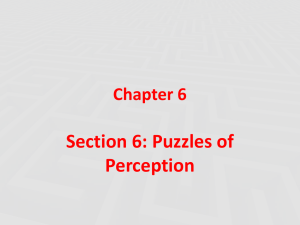recognize meaningful objects and events. of information into meaningful wholes. ground
advertisement
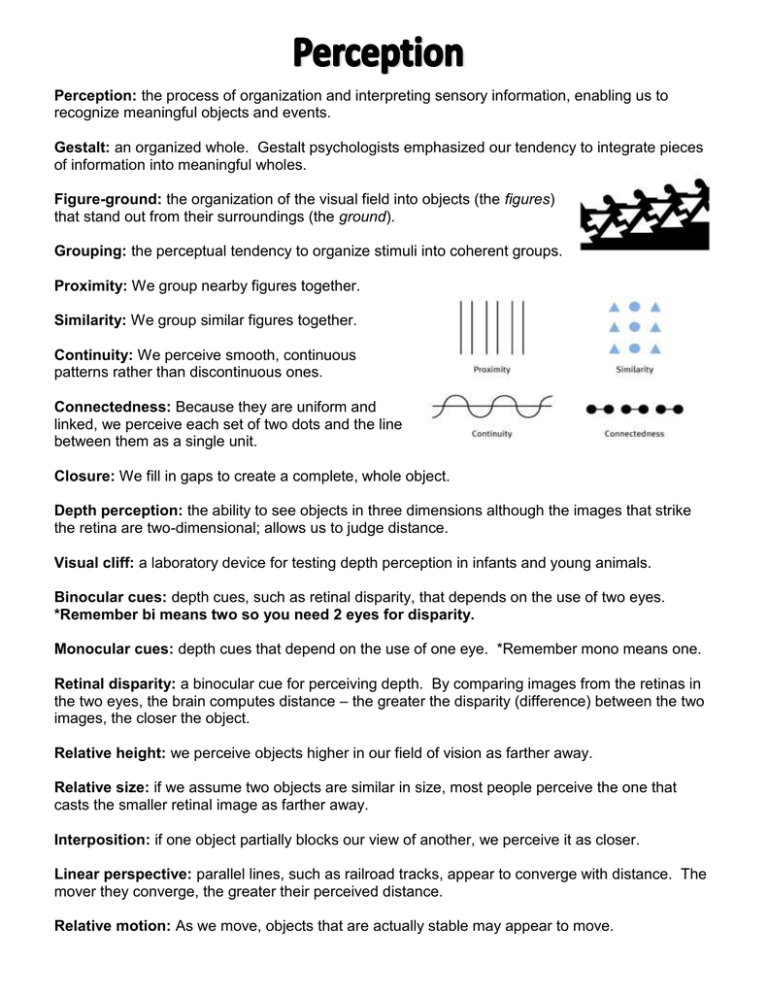
Perception: the process of organization and interpreting sensory information, enabling us to recognize meaningful objects and events. Gestalt: an organized whole. Gestalt psychologists emphasized our tendency to integrate pieces of information into meaningful wholes. Figure-ground: the organization of the visual field into objects (the figures) that stand out from their surroundings (the ground). Grouping: the perceptual tendency to organize stimuli into coherent groups. Proximity: We group nearby figures together. Similarity: We group similar figures together. Continuity: We perceive smooth, continuous patterns rather than discontinuous ones. Connectedness: Because they are uniform and linked, we perceive each set of two dots and the line between them as a single unit. Closure: We fill in gaps to create a complete, whole object. Depth perception: the ability to see objects in three dimensions although the images that strike the retina are two-dimensional; allows us to judge distance. Visual cliff: a laboratory device for testing depth perception in infants and young animals. Binocular cues: depth cues, such as retinal disparity, that depends on the use of two eyes. *Remember bi means two so you need 2 eyes for disparity. Monocular cues: depth cues that depend on the use of one eye. *Remember mono means one. Retinal disparity: a binocular cue for perceiving depth. By comparing images from the retinas in the two eyes, the brain computes distance – the greater the disparity (difference) between the two images, the closer the object. Relative height: we perceive objects higher in our field of vision as farther away. Relative size: if we assume two objects are similar in size, most people perceive the one that casts the smaller retinal image as farther away. Interposition: if one object partially blocks our view of another, we perceive it as closer. Linear perspective: parallel lines, such as railroad tracks, appear to converge with distance. The mover they converge, the greater their perceived distance. Relative motion: As we move, objects that are actually stable may appear to move. Light and shadow: nearby objects reflect more light to our eyes. Thus, given two identical objects, the dimmer one seems farther away. Shading, too, produces a sense of depth consistent with our assumption that light comes from above. Phi Phenomenon: an illusion of movement created when two or more adjacent lights blink on and off in quick succession, like Christmas lights. Perceptual constancy: perceiving objects as unchanging (having consistent shapes, size, lightness, and color) even as illumination and retinal images change. Color constancy: perceiving familiar objects as having consistent color, even if changing illumination alters the wavelengths reflected by the object. Perceptual adaptation: in vision, the ability to adjust to an artificially displaced or even inverted visual field. This is usually done with distorting lenses. When the lenses are removed, it takes some time for perception to return to “normal”. Perceptual set: a mental predisposition to perceive one thing and not another. Schema: Organized bodies of information that are stored in memory which can bias the way new information is interpreted, stored, and recalled. Context effects: describes the influence of environmental factors on one's perception of a stimulus. Parapsychology: the study of paranormal phenomena, including ESP and psychokinesis. Extrasensory Perception (ESP): the controversial claim that perception can occur apart from sensory input; includes telepathy, clairvoyance, and precognition. Telepathy: mind-to-mind communication, one person sending thoughts to another or perceiving another’s thoughts. Clairvoyance: perceiving remote events, such as sensing that a friend’s house is on fire. Precognition: perceiving future events, such as a political leader’s death or a sporting event’s outcome. Muller-Lyer: Necker Cube: Ponzo Illusion:
